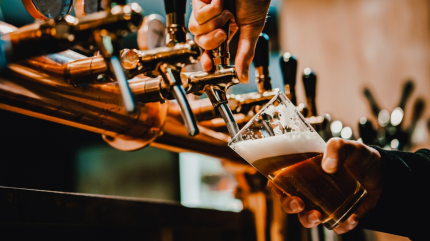
As competition from other beverage categories intensifies and people continue to drink less alcohol, brewers have their work cut out to ensure long-term sustainability.
The headwinds facing the category are not unique: Covid-19, cost pressures, inflation, pressure to invest in sustainability, intense competition from other categories, diminishing interest in alcohol globally.
At last month’s International Beer Strategies Conference in Portugal, premiumisation was oft touted as the best way to stay afloat, as people drink less but are supposedly willing to spend more per pint.
Others at the conference, organised by Just Drinks’ sister events arm, Arena, highlighted the importance of innovation, of brand building and even “cross-category blurring”.
Combatting volume losses with a ‘premium’ offering
The value of global beer sales is predicted to outpace volume over the next four years, growing at a 3.9% five-year CAGR between 2023-2028, according to drinks analysts at GlobalData, Just Drinks’ parent company.
Volume sales, meanwhile, are predicted to see a slower five-year CAGR of 1.3%. Between 2019 and 2022, the CAGR of beer sales declined 0.1% in volume, while value grew 3%.
Marmite word though it may be, many speakers cited ‘premiumisation’ as the best answer to slowing volume sales of beer.
“Premiumisation might not be a guaranteed way out to profitability, but it looks the only path to follow,” Rabobank analyst Francois Sonneville said following the event.
During economic crises, people drink more premium beer.
Kevin Baker, head of global beer and cider research at GlobalData, said the move towards premium products had been happening for “ten years plus” and was “ultimately a value-driven proposition”.
“One of the things that happens during economic crises is people drink more premium beer, which seems really counterintuitive until you realise it’s actually to do with value for money,” Baker told delegates.
In 2022, the ‘super premium’ and ‘premium’ beer categories grew 5.8% and 5.6% respectively, compared to the previous year, according to GlobalData. These two price segments formed just over a quarter of beer sales in 2022.
This compares to ‘mainstream’ beer, which grew 2.3% and accounts for 60% of beer sales, and ‘discount’ beer, which dropped 1.8% on 2021, holding a 13% share.
Damm international business unit director Juan Gonzalez said the Estrella-Damm brand owner evaluates market maturity as a base for its premiumisation strategy.
In markets in earlier stages of maturity, people are “getting into beer”, alcohol has “smaller penetration” and consumers are drinking at around 50 “occasions” per year, Gonzalez said. Drinking is focused around social occasions and the variety of beverages drunk is lower – and is led by beer.
At later stages of maturity, people consume alcohol on an almost daily basis, begin drinking more at home and in different occasions, and “we start to see premiumisation”. There is higher risk of drinkers leaving the category to find non-alcoholic beverages or “something more sophisticated” than beer, Gonzalez said.
The amount of alcohol drunk per occasion also declines in mature markets, and Gonzalez warned: “At some point in time, [beer consumption] will stagnate or decline. When your market is premiumising, you are not only competing for share of beer, you are also competing for share of throat.”
In order to stem the loss of consumers, he touted world lager as “the segment to play in”. Damm estimates that in the UK, this segment – which includes brands like Estrella Damm, Peroni and Super Bock – accounts for 30% of beer sales.
Using the UK on-premise as an example of a mature market, internal research at Damm has shown premium, craft and world lagers have taken tap share from standard lagers and traditional cask ales. Gonzalez noted a “clear differentiation” in the on-premise in 2024 – with premium lager (4% abv), world lager and craft beer taking two or three taps on a bar each, compared to an average of five taps for all “premium” beer combined in 2018.
With consumers often non-brand-loyal within premium beers, regularly drinking two or more brands, Gonzalez said launching (or relaunching) beers and developing new products is essential. “If you have only one world beer lager in your repertoire, you're missing half of the opportunity,” he added.
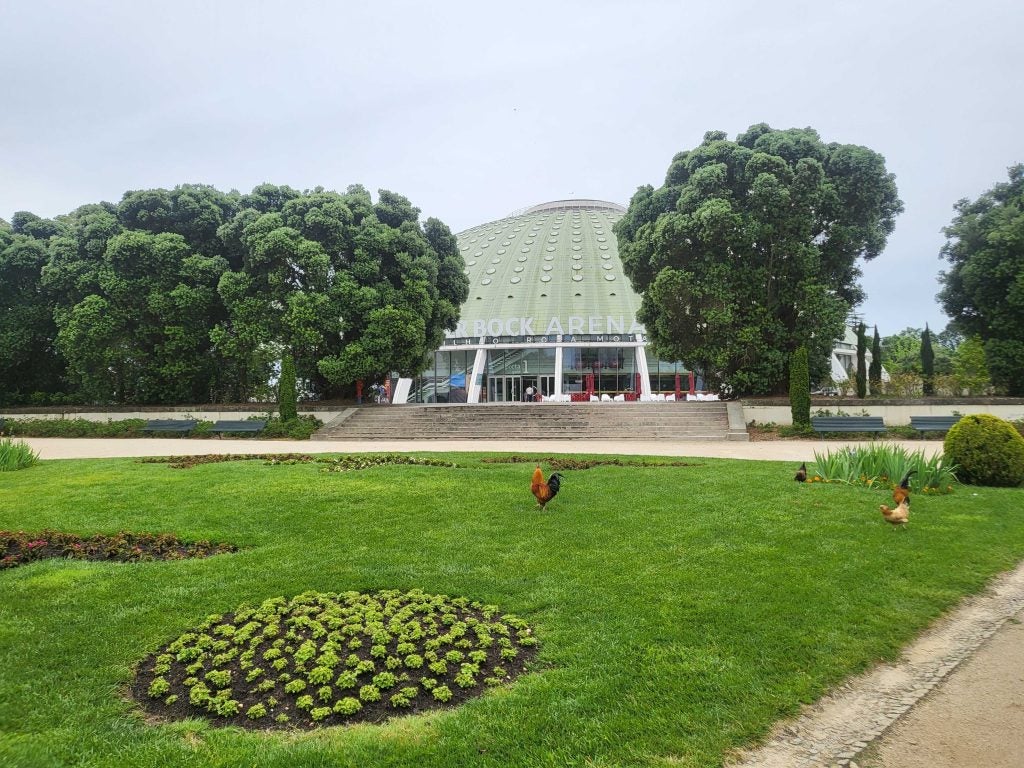
Competition from other categories
Baker noted a hubbub at the conference around “the potential threat posed by the growth of flavored alcoholic beverages”.
GlobalData defines flavoured alcoholic beverages (FABs) as “low-alcohol spirit mixes, often vodka or rum based”. In the US, these products are often made with malt-derived alcohol, but the data and analytics firm said its definition also includes “fruit-based drinks and pre-mixed versions of classic cocktails, wine coolers and Japanese Chu-Hi products (based on shochu)”.
The data and analytics firm predicts FABs will overtake whisk(e)y and vodka in the US in value sales by 2027, as key players continue to invest in the category.
Baker said FABs have “cross-generational appeal” and their growth has been led by pre-mixed spirits, which offer “an easy-to-drink alcoholic beverage combined with the sophistication of cocktails”.
How, then, can brewers defend shelf space against such stiff competition?
GlobalData cited novelty, uniqueness and authenticity as key drivers behind the exploration of RTDs – each of which can be tapped into by innovative brewers.
New York-based Brooklyn Brewery has been experimenting with what CEO Eric Ottaway called “category blurring” – mixing its beers with other categories, like wine.
Brooklyn has upcycled leftover pomace (grape skins, seeds and pulp left over after fermentation and filtration) to produce beers that “blurr” the line between beer and sparkling wine. These include Swirling Rumours, which Ottaway said tastes like orange wine, Facts On The Ground, which is like rosé, and Brooklyn Megapurple, a sour Ottaway compared to Lambrusco.
These experimental releases are only served at Brooklyn’s tap room and are not (yet) produced for commercial release, but Ottaway feels they “have huge potential” in a wider market. “I think people are looking for new, interesting products,” he told Just Drinks.
Although technically a beer – with all alcohol derived from beer and only flavours from the grapes – Ottoway said: “You wouldn’t sell it as a beer. Honestly, it would probably be closer to the RTD world. I don’t think a retailer is ever going to stock it on the wine shelf but it would play in that [alternative packaging space], whether it’s wine in a can or Tetra Pak for on-the-go beach, hiking, picnic occasions. That’s where I could see that being super successful.”
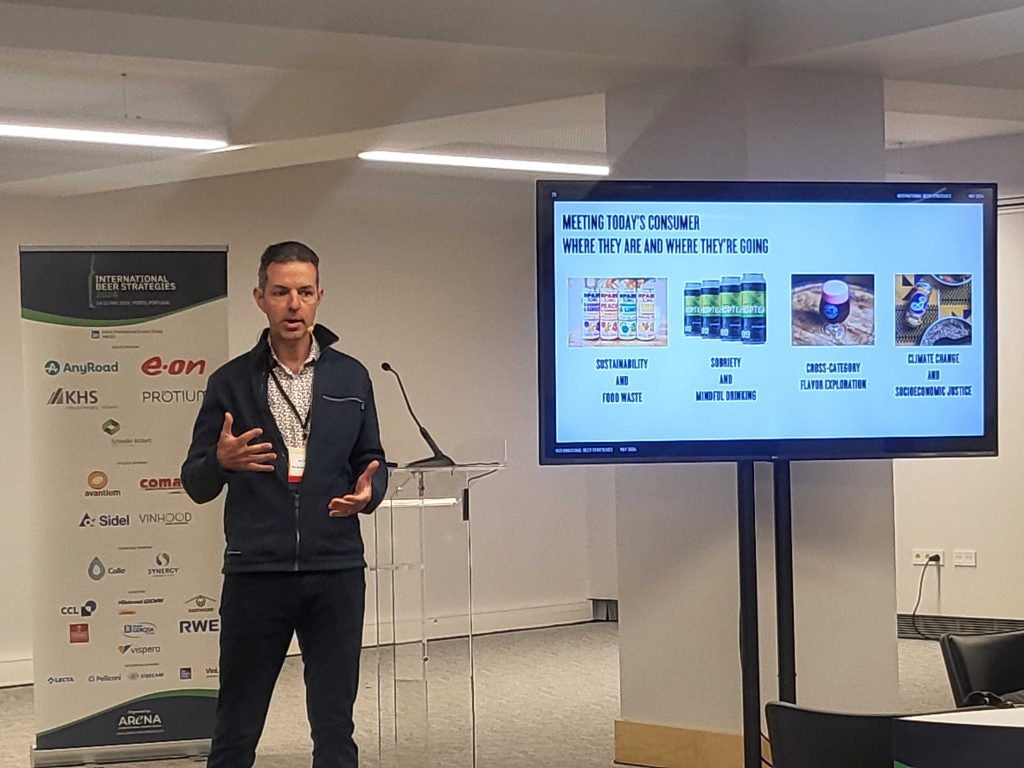
He added: “From a taxation standpoint, there’s also a huge advantage because beer is typically taxed almost everywhere at a much lower rate than wine or spirits. If we can essentially derive wine flavour from something that’s technically a beer, that’s a win-win.”
Lukas Neulen, a business unit director at Carlsberg’s Swiss arm Feldschlösschen Getränke, also touted the potential for cross-sector blurring in beer.
“There is no monopoly on the consumer, it’s much more about the consumption occasion,” he said. “We need to break the stigma that there is one consumer just going for one product, because in all other categories this has always been a given.”
Neulen used the example of Carlsberg Group's Swiss beer brand Valaisanne, which collaborated with Pernod Ricard brand Jameson to produce an imperial brown ale aged in Irish-whiskey casks.
“The interesting part here is not necessarily the product, but it's the route to market afterwards,” Neulen said. “This beer was sold by the spirits sales force, because the upside for us was that we wanted to bridge – with that beer – into the category of whisk(e)y drinkers.”
Tempting drinkers with new flavours
There has been a recent boom in experimentation with unusual flavours within beer, particularly sours – such as London brewery Orbit’s Tzatziki Sour and Scottish brewer Vault City Brewing’s Iron Brew Sour.
UK-based Synergy Flavours, which manufactures flavorings, extracts and essences, highlighted flavoured beers as one way to tempt new, or deserting, drinkers (back) to the category. Synergy defines a flavoured beer as one that advertises a particular flavour, such as a fruit, and is inclusive of radlers – a mixture of lager and lemonade.
Paola Bassi, Synergy Flavours Europe marketing director, said: “We know there are people who could be interested in [flavoured beer NPD], for variety, for refreshment – and we know that those people, the 20-34-year olds, are also looking outside the category to get that need or satisfaction. The industry needs to make sure they don’t lose them completely.”
Synergy’s internal research showed drinkers – particularly younger generations – were more interested in bitter flavours over sweet additions to their beer.
Matthew Hoyland, Synergy Flavours process development chemist, said there was a gap in the market for bitter-flavoured beers. “It’s a very long-standing ideology that young people like sweet things, when actually [the data is] not showing that at the moment in this category,” he added.
Synergy produces ‘natural’ flavourings which can be added to beers (by brewers, not drinkers) to enhance their flavour. It has also launched a hop-flavoured ‘essence’ which can be added to low- and-no-alcohol beers to add back some of the flavour lost in the production process.
Hop water: Creating shelf space with NPD
The trend towards home drinking remains strong as the cost of living pinches household budgets and people forego “lavish nights out” in the on-premise, GlobalData research suggests. A dip in on-premise sales volumes since the pandemic has “yet to see global recovery”, the data and analytics firm said, and “looks to lag behind for the foreseeable future”.
“The home is generally a relaxed environment where beverage consumption has a strong comfort component,” Baker said. “Drinking at home provides a sense of relaxation and familiarity that is not available when among strangers.”
He added: “The ability to purchase at store prices means consumers can engage more in premium alcoholic beverages that may have otherwise been outside of their budget.”
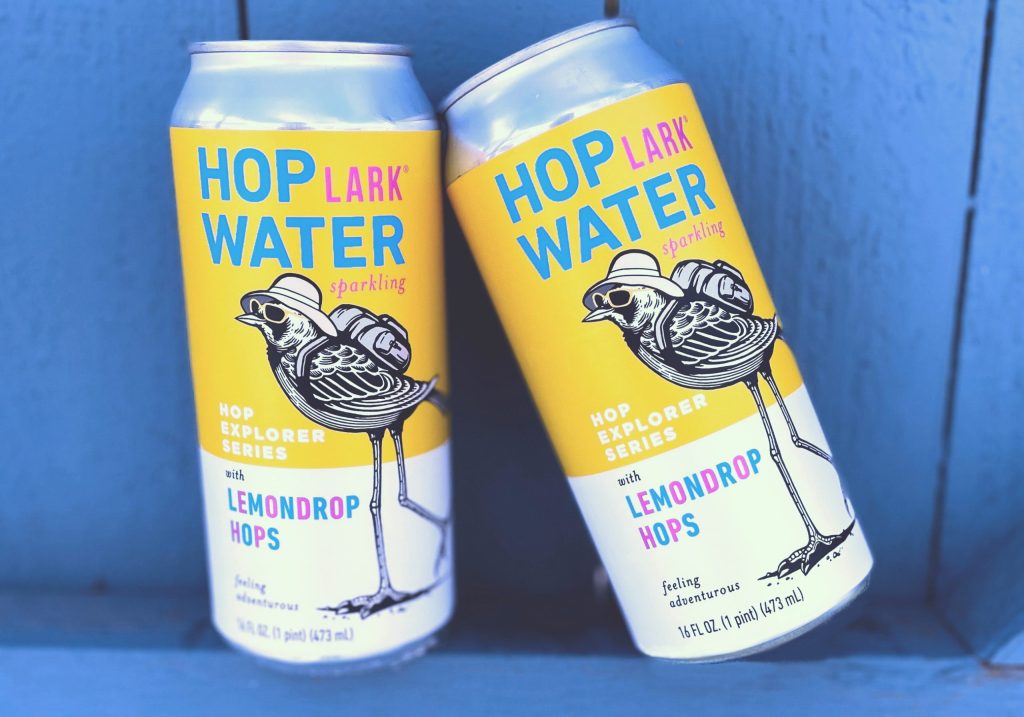
Producing hop water is one way for brewers to expand off-premise shelf space in a competitive market, Ottoway said. Brooklyn purchased a share in non-alcoholic drinks company Hoplark last year, which produces hop-infused water, tea and sparkling water. The two companies also have a “strategic partnership” that covers production, logistics and sales.
“The interesting thing to me about [Hoplark] is that, as brewers, we're all stuck essentially fighting the same aisle,” he said. “We're all fighting over shelf space. They've taken the traditional beer ingredient, hops, outside of the beer aisle and are now able to compete in other parts of the supermarket.
“Hoplark tea is stocked with the iced tea, the waters are stocked wherever they stock the sparkling water. So now, all of a sudden, you've taken beer outside of your aisle and are essentially enlarging your own market.”
Baker highlighted that while consumers can be more willing to experiment with flavours and products when drinking at home, they are also more likely to purchase drinks from multi-national brands, “suggesting that brand recognition remains extremely important”.
Low and no
As might be expected, conversations on low-and-no products abounded last month. With the emergence of specialists like Athletic Brewing in the US or Big Drop in the UK, and the march of multinationals like Heineken and Asahi into the sector, alcohol-free beer, while still small, is undoubtedly eating into the sales of conventional brews in North America and western Europe.
In 2023, Germany was the world’s largest consumer of low-and-no beer, followed by Japan, Spain and the US – though Heineken recently told Just Drinks markets like the US, UK and South Africa “have not grown at the levels that were predicted yet”.
Rui Lopes Ferreira, CEO of Portuguese brewing stalwart Super Bock Group, said he had “no doubt” the category would grow over the next two decades but was cautious about over-egging its potential.
“I think the demand will rise. It will not be a surge curve but it will consistently develop, I have no doubts,” he said. “I believe it will grow, and at Super Bock we are well positioned to profit of that market development because we have been investing [in the area].”
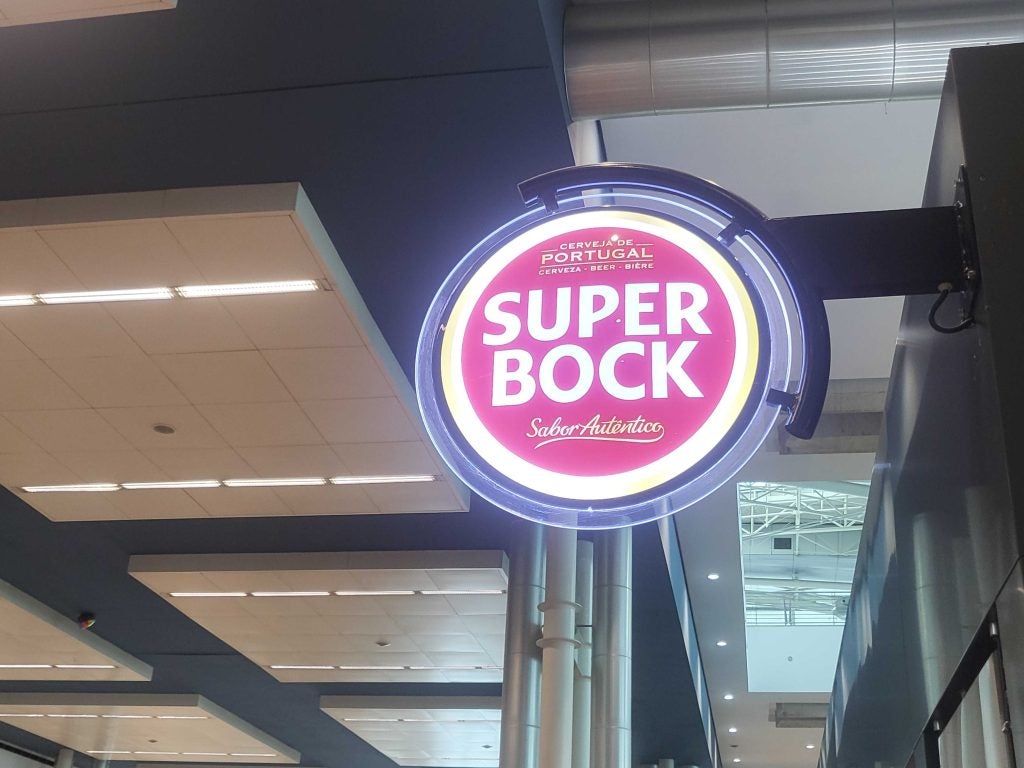
Super Bock Group, which is 56% owned by Portugal’s Viacer Group and 44% by the Carlsberg Group, has a range of non-alcoholic versions of its flagship brand, as well as non-alcoholic brand Cheers. Its Porto-based brewery also produces 0.0% pear cider for Carlsberg brand Somersby.
In the US, Ottoway said the uptake of low-and-no beer has been slower but will continue to grow, driven by health and wellness trends.
“Will the non-alcoholic market ever become 5% or 10% in the US, like some European markets? It’s unclear,” he said. “But what is clear is that with today’s consumers, particularly the younger consumer, being much more mindful – both about their alcoholic intake but also about general healthiness – is that I think there will be an increasing role in lower alcohol, whether that’s all the way to zero or just lower than traditional – that segment actually can become quite large.”
Demand for low-and-no beer continues to be led by younger generations; GlobalData research shows Gen Z (born between 2000 and 2010) drink low- or no-alcohol alternatives regularly (four days a week or more) more than any other generation. Gen Y (Millennials, born between 1981 and 1999) are also key consumers, while nearly 50% of Boomers (born between 1946 and 1965) say they never drink low- or no-alcohol drinks.
While many attribute changing trends in alcohol consumption to younger drinkers, GlobalData’s Baker isn’t convinced these will necessarily move the needle long term.
“My personal feeling is that the whole Gen Z thing might be over-exaggerated. Whilst there are clearly some areas where Gen Z differ from other generations, quite a lot of supposed generational attributes are actually to do with life-stages and they may revert to behaviours closer to the norm as they get older.”
Amid undeniable headwinds in the industry, one attendee at last month’s International Beer Strategies Conference described the atmosphere as “subdued”, adding: “Times are not very easy for brewers”. On day two of the event, North Brewing founder John Gyngell told the audience how his company ended up in administration earlier this year following the triple whammy of Brexit, Covid and inflation.
But amid these serious pressures, both small and larger brewers at the conference remained upbeat, sharing a stream of ideas for navigating future storms.
Asked whether he would encourage others to start a brewery, Gyngell said without hesitation: “Do it.” He added: “I've had nine years of the most amazing time. We’re in Porto talking about beer. How lucky are we?”


